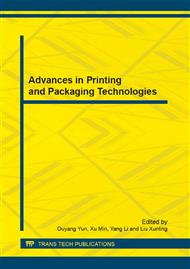p.307
p.311
p.315
p.320
p.324
p.329
p.334
p.340
p.345
Study on the Printability of UV-Curable Inkjet Ink on Different Printed Materials
Abstract:
The printed materials used for UV-curable inkjet ink have diversity, in order to research the differences of the printability of UV-curable inkjet ink on different printed materials and improve the printing quality of UV-curable inkjet ink printing on different materials, this research select coated paper, glass card adhesive paper, PVC plastic film as printed materials. After printing the same UV-curable inkjet ink,the printing quality indicators of printing proofs including the density of the line, blurriness, raggedness, line width and contrast of printing product lines were tested,and then test the contact angle of UV-curable inkjet ink on three printed materials, combined with wetting situation,analysis the printing quality of UV ink-jet ink on different substrate, prepare UV ink-jet ink with different printability, printing and testing the printing quality, assessing the quality with comprehensive evaluation method. The result shows that it's existed large differences among the printing quality of the same UV-curable inkjet inks printing on different materials. We match the printed materials with the corresponding printability of UV-curable inkjet inks in the practical production, in order to get the best printing results.
Info:
Periodical:
Pages:
324-328
Citation:
Online since:
December 2012
Authors:
Price:
Сopyright:
© 2013 Trans Tech Publications Ltd. All Rights Reserved
Share:
Citation:


